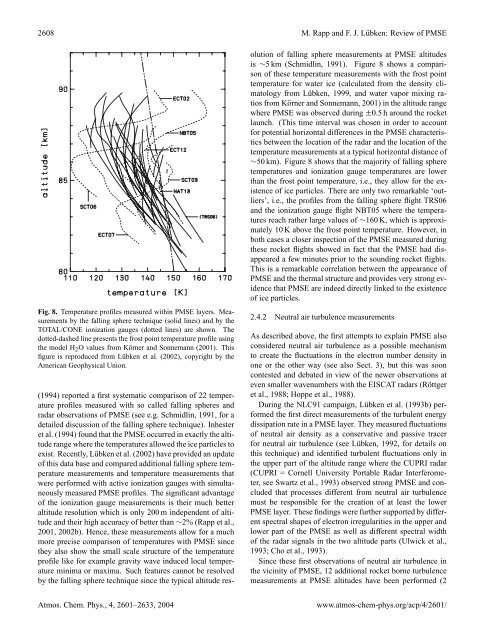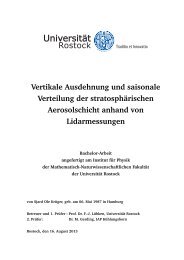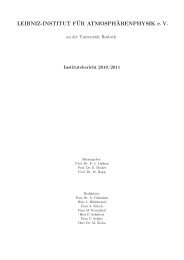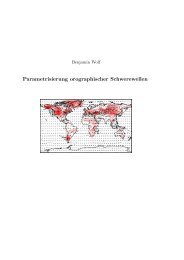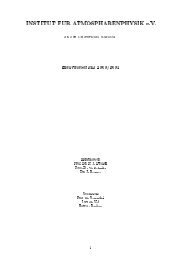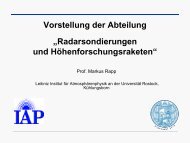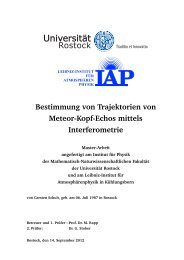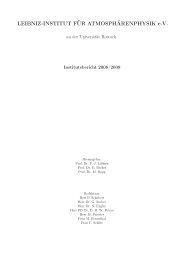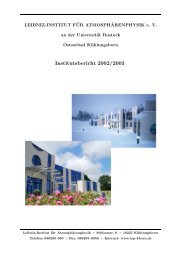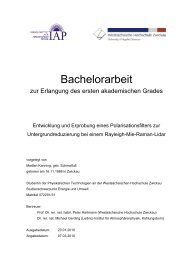Polar mesosphere summer echoes (PMSE): review of ... - HAL
Polar mesosphere summer echoes (PMSE): review of ... - HAL
Polar mesosphere summer echoes (PMSE): review of ... - HAL
You also want an ePaper? Increase the reach of your titles
YUMPU automatically turns print PDFs into web optimized ePapers that Google loves.
2608 M. Rapp and F. J. Lübken: Review <strong>of</strong> <strong>PMSE</strong><br />
Fig. 8. Temperature pr<strong>of</strong>iles measured within <strong>PMSE</strong> layers. Measurements<br />
by the falling sphere technique (solid lines) and by the<br />
TOTAL/CONE ionization gauges (dotted lines) are shown. The<br />
dotted-dashed line presents the frost point temperature pr<strong>of</strong>ile using<br />
the model H 2 O values from Körner and Sonnemann (2001). This<br />
figure is reproduced from Lübken et al. (2002), copyright by the<br />
American Geophysical Union.<br />
(1994) reported a first systematic comparison <strong>of</strong> 22 temperature<br />
pr<strong>of</strong>iles measured with so called falling spheres and<br />
radar observations <strong>of</strong> <strong>PMSE</strong> (see e.g. Schmidlin, 1991, for a<br />
detailed discussion <strong>of</strong> the falling sphere technique). Inhester<br />
et al. (1994) found that the <strong>PMSE</strong> occurred in exactly the altitude<br />
range where the temperatures allowed the ice particles to<br />
exist. Recently, Lübken et al. (2002) have provided an update<br />
<strong>of</strong> this data base and compared additional falling sphere temperature<br />
measurements and temperature measurements that<br />
were performed with active ionization gauges with simultaneously<br />
measured <strong>PMSE</strong> pr<strong>of</strong>iles. The significant advantage<br />
<strong>of</strong> the ionization gauge measurements is their much better<br />
altitude resolution which is only 200 m independent <strong>of</strong> altitude<br />
and their high accuracy <strong>of</strong> better than ∼2% (Rapp et al.,<br />
2001, 2002b). Hence, these measurements allow for a much<br />
more precise comparison <strong>of</strong> temperatures with <strong>PMSE</strong> since<br />
they also show the small scale structure <strong>of</strong> the temperature<br />
pr<strong>of</strong>ile like for example gravity wave induced local temperature<br />
minima or maxima. Such features cannot be resolved<br />
by the falling sphere technique since the typical altitude resolution<br />
<strong>of</strong> falling sphere measurements at <strong>PMSE</strong> altitudes<br />
is ∼5 km (Schmidlin, 1991). Figure 8 shows a comparison<br />
<strong>of</strong> these temperature measurements with the frost point<br />
temperature for water ice (calculated from the density climatology<br />
from Lübken, 1999, and water vapor mixing ratios<br />
from Körner and Sonnemann, 2001) in the altitude range<br />
where <strong>PMSE</strong> was observed during ±0.5 h around the rocket<br />
launch. (This time interval was chosen in order to account<br />
for potential horizontal differences in the <strong>PMSE</strong> characteristics<br />
between the location <strong>of</strong> the radar and the location <strong>of</strong> the<br />
temperature measurements at a typical horizontal distance <strong>of</strong><br />
∼50 km). Figure 8 shows that the majority <strong>of</strong> falling sphere<br />
temperatures and ionization gauge temperatures are lower<br />
than the frost point temperature, i.e., they allow for the existence<br />
<strong>of</strong> ice particles. There are only two remarkable ‘outliers’,<br />
i.e., the pr<strong>of</strong>iles from the falling sphere flight TRS06<br />
and the ionization gauge flight NBT05 where the temperatures<br />
reach rather large values <strong>of</strong> ∼160 K, which is approximately<br />
10 K above the frost point temperature. However, in<br />
both cases a closer inspection <strong>of</strong> the <strong>PMSE</strong> measured during<br />
these rocket flights showed in fact that the <strong>PMSE</strong> had disappeared<br />
a few minutes prior to the sounding rocket flights.<br />
This is a remarkable correlation between the appearance <strong>of</strong><br />
<strong>PMSE</strong> and the thermal structure and provides very strong evidence<br />
that <strong>PMSE</strong> are indeed directly linked to the existence<br />
<strong>of</strong> ice particles.<br />
2.4.2 Neutral air turbulence measurements<br />
As described above, the first attempts to explain <strong>PMSE</strong> also<br />
considered neutral air turbulence as a possible mechanism<br />
to create the fluctuations in the electron number density in<br />
one or the other way (see also Sect. 3), but this was soon<br />
contested and debated in view <strong>of</strong> the newer observations at<br />
even smaller wavenumbers with the EISCAT radars (Röttger<br />
et al., 1988; Hoppe et al., 1988).<br />
During the NLC91 campaign, Lübken et al. (1993b) performed<br />
the first direct measurements <strong>of</strong> the turbulent energy<br />
dissipation rate in a <strong>PMSE</strong> layer. They measured fluctuations<br />
<strong>of</strong> neutral air density as a conservative and passive tracer<br />
for neutral air turbulence (see Lübken, 1992, for details on<br />
this technique) and identified turbulent fluctuations only in<br />
the upper part <strong>of</strong> the altitude range where the CUPRI radar<br />
(CUPRI = Cornell University Portable Radar Interferometer,<br />
see Swartz et al., 1993) observed strong <strong>PMSE</strong> and concluded<br />
that processes different from neutral air turbulence<br />
must be responsible for the creation <strong>of</strong> at least the lower<br />
<strong>PMSE</strong> layer. These findings were further supported by different<br />
spectral shapes <strong>of</strong> electron irregularities in the upper and<br />
lower part <strong>of</strong> the <strong>PMSE</strong> as well as different spectral width<br />
<strong>of</strong> the radar signals in the two altitude parts (Ulwick et al.,<br />
1993; Cho et al., 1993).<br />
Since these first observations <strong>of</strong> neutral air turbulence in<br />
the vicinity <strong>of</strong> <strong>PMSE</strong>, 12 additional rocket borne turbulence<br />
measurements at <strong>PMSE</strong> altitudes have been performed (2<br />
Atmos. Chem. Phys., 4, 2601–2633, 2004<br />
www.atmos-chem-phys.org/acp/4/2601/


